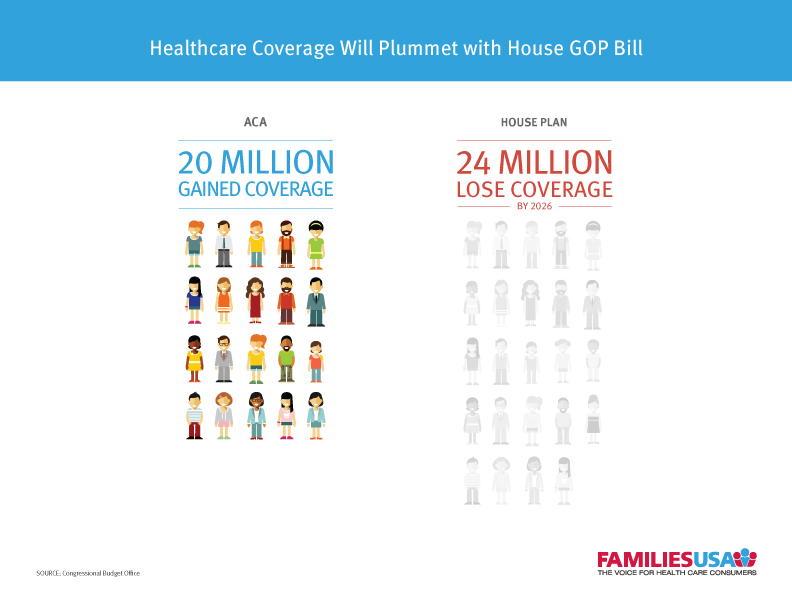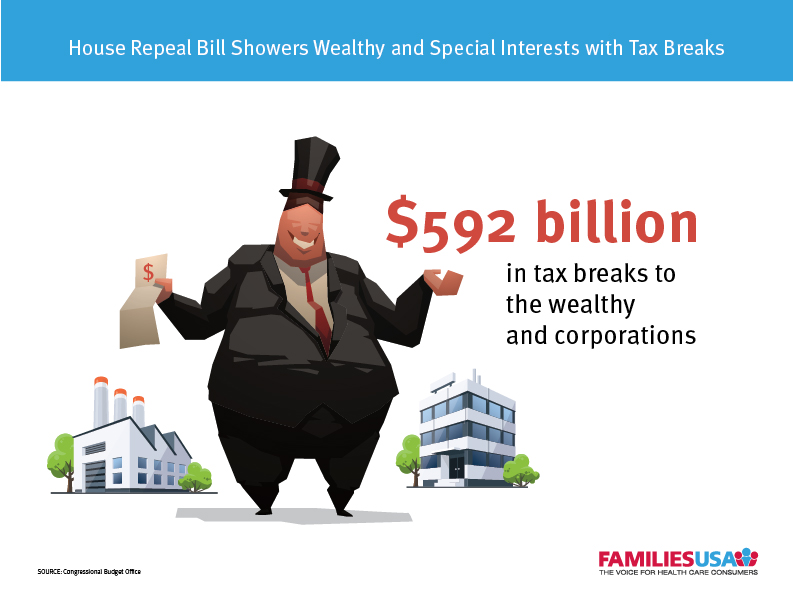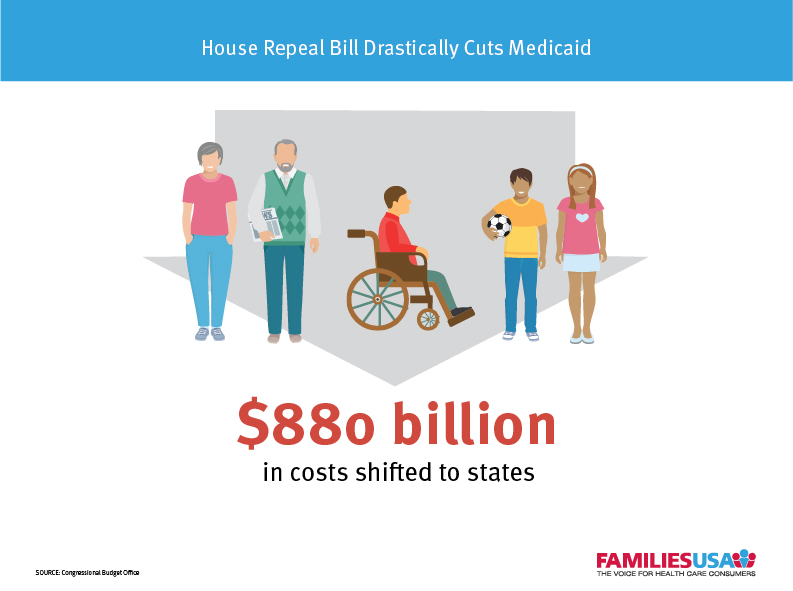Talking Points: CBO’s Score of The American Health Care Act
03.13.2017
The non-partisan Congressional Budget Office (CBO) has confirmed what we already know: The American Health Care Act (AHCA) would wreak havoc on the health care system. The bill would increase costs for consumers while providing less coverage. The AHCA would benefit the healthy and wealthy while inflicting far-reaching harm on children, seniors, low-income consumers, those with disabilities, and more. Despite Congressional leaders’ assertions, this plan does nothing to improve choice or affordability.
- In 10 years, a total of 24 million more people will be uninsured under the AHCA than is projected under current law. All told, the uninsured rate under the House Republicans’ bill will be higher than before the ACA was passed.
- $880 billion dollars will be cut from the Medicaid program through elimination of the Medicaid expansion and a fundamental restructure of the Medicaid program. This massive, unprecedented cost shift to states means 14 million people will lose Medicaid coverage and millions of seniors, disabled individuals, and other vulnerable populations who rely on the program will be at risk.
- Premiums and out-of-pocket costs will increase, particularly for older adults and those with lower incomes. At the same time, plans available on the marketplace will be less comprehensive than they are today—meaning individuals will be paying more for less.
In-Depth Talking Points:
- Uninsured: Under this bill, the number of uninsured people will skyrocket and dramatically increase over time.
- By 2026, 24 million more people will be uninsured than under current law. This means that in 2026, 52 million people would be uninsured. Under current law, 28 million people would be uninsured by 2026.
- In 2018 alone, 14 million more people will be uninsured than would be under current law.
- By 2020, roughly 17 percent of non-elderly adults (or 48 million people) will be uninsured. That is 21 million more people than we’d see under the Affordable Care Act.

- Out-of-Pocket Costs: Plans will cover a lower share of health care costs, so consumers will face higher deductibles and cost-sharing. Low-income consumers will be particularly affected by these higher out-of-pocket costs.
- Premiums: Premiums will significantly increase for older and low-income consumers, leaving many with no option for affordable coverage.
- A stark example included in the analysis shows that a 64-year old making 175 percent of the federal poverty level (or $26,500 a year) will see his or her yearly premium increase nearly $13,000.
- Tax Breaks: This bill is a giveaway to wealthy individuals and corporations: The legislation would provide nearly $600 billion in tax breaks to high-income earners and health insurers.

- Types of Coverage: This bill will negatively impact people with all different types of health coverage. In 2020, compared to current law:
- 9 million fewer people will have coverage through the individual market
- 9 million fewer people will be covered through Medicaid
- 2 million fewer people will have coverage through their employer
- Cost Shift to States: This bill would cut $880 billion in federal Medicaid spending over 10 years, passing those costs on to states. As a result, 14 million fewer people would have Medicaid coverage.
- The bill would effectively end the Medicaid expansion by phasing out the expansion’s enhanced federal funding.
- The bill would end Medicaid’s guaranteed federal funding match and replace it with capped funding that will grow slower than state Medicaid costs.
- Capping and cutting Medicaid will affect every state, whether it expanded coverage or not.
- By 2026, federal Medicaid spending will be cut by 25 percent. With cuts of that magnitude, every state will be affected.
- CBO even acknowledges that states will be left making hard decisions. As they said in the report, “with less federal reimbursement for Medicaid, states would need to decide whether to commit more of their own resources to finance the program…or whether to reduce spending by cutting payments to health care providers and health plans, eliminating optional services, restricting eligibility for enrollment, or (to the extent feasible) arriving at more efficient methods for delivering services.”1

- State Economies: Federal funds make up more than half of state Medicaid budgets.2 Taking $880 billion out of state economies will have a significant ripple effect and every state will be hit at some level.
- The economic impact of an $880 billion federal funding cut to states would be felt in employment losses, reduced business activity, and state and local tax losses.3
Republicans’ Efforts to Sweep CBO’s Analysis Under the Rug
- 24 million more uninsured by 2026 falls far short of Speaker Ryan’s pledge that “no one will be worse off” and President Trump’s assertion that everyone will get coverage.4 It’s no wonder House Republicans have attempted to rush this bill through Congress, and until now we did not even have a formal estimate of the bill’s impact. It is clear that the reason Congressional Republicans are rushing and have only allowed for limited debate is because they don’t want people to see the negative impact this would have on families.
- Before these estimates even came out, Republicans tried to dismiss the analysis and the non-partisan Congressional Budget Office who conducted it. This is despite the fact that the CBO director was appointed—and praised—by Republicans.
Endnotes
1Congressional Budget Office Cost Estimate, American Health Care Act, March 13, 2017 available online at https://www.cbo.gov/sites/default/files/115th-congress-2017-2018/costestimate/americanhealthcareact.pdf.
2MacPac, Medicaid’s Share of State Budgets, available online at https://www.macpac.gov/subtopic/medicaids-share-of-state-budgets/
3An earlier analysis looking at just repeal of the Medicaid expansion, using a substantially lower funding cut of $466 billion from 2019-2023, found that federal funding cuts at that level would lead to nearly $900 billion reduction in gross state product and 1.7 million fewer people with jobs in 2023. Losses from a substantially greater $880 billion cut would be greater. See: Leighton Ku, et al., Repealing Federal Health Reform: Economic and Employment Consequences for States,” (Washington, DC: Commonwealth Fund, January, 2017), available online at http://www.commonwealthfund.org/publications/issue-briefs/2017/jan/repealing-federal-health-reform
4Craig Gilbert, ”Paul Ryan: Obamacare phaseout will leave ‘no one worse off’,” USA Today, December 5, 2016 online at http://www.usatoday.com/story/news/politics/2016/12/05/paul-ryan-obamacare-phaseout-leave-no-one-worse-off/95002488/; and, Robert Costa and Amy Goldstein, “Trump vows ‘insurance for everybody’ in Obamacare replacement plan,” The Washington Post, January 15, 2017 online at https://www.washingtonpost.com/politics/trump-vows-insurance-for-everybody-in-obamacare-replacement-plan/2017/01/15/5f2b1e18-db5d-11e6-ad42-f3375f271c9c_story.html



